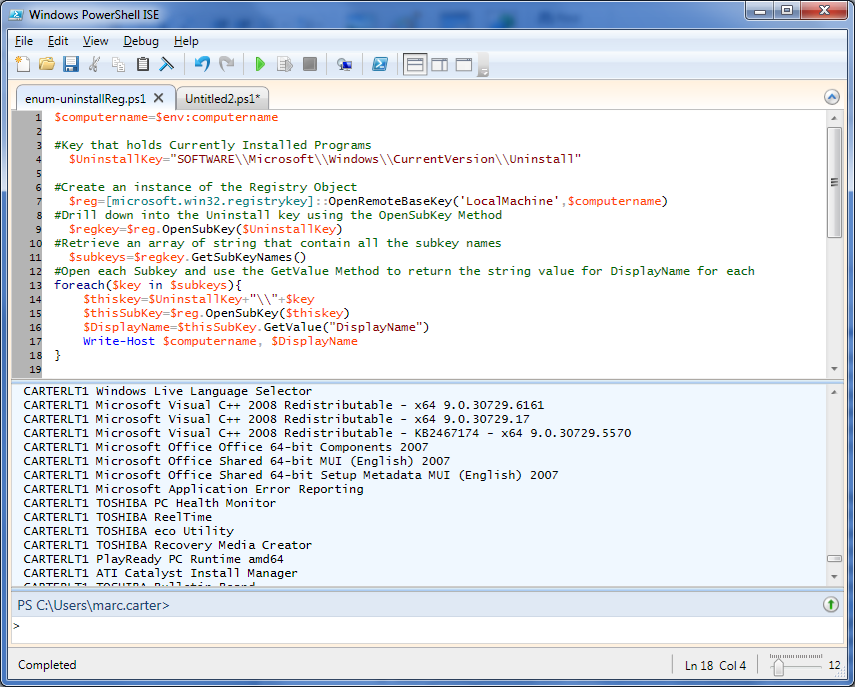Working on Remote Registry is always challenging. If you are administrator, I am sure you would have come across various times that you wanted to update registry of the computer and you have to login to the each server and apply the registry. Powershell has made most of our administrator’s life easier. Let’s understand how we can access and edit registry of remote computer using powershell
Let’s understand code with example. Below Script take the list of server name in CSV file and reads each server name one by one and opens the registry Key and prints the value. In this fashion you can get any key and get the value. In the below script I am trying to get the value of HKEY_CurrentUsers. This is the reason current in OpenRemoteBaseKey. If you Access keys of HKEY_Localmachine and use LocalMachine
PowerShell 7 delegation with ScriptRunner Thu, Jul 23 2020. If you are using PowerShell to manage your environment today, there may be challenges with centraliz. Veeam Backup for Office 365 v4 Tue, May 12 2020. Backing up the data in Office 365 is extremely important. In this review of Veeam Backup for Office.
The nice thing about this command is you can also specify alternate credentials. However, it does require that WsMan is correctly configured for powershell remoting to work. Which, 9 times out of 10 in most environments it is not. Option 2 – The Microsoft.Win32.RegistryKey Class. Assigning Permissions to a Registry Key. Click the key that you want to assign permissions. On the Edit menu, click Permissions. Click the group or user name that you want to work with.
If you wanted to get the list of subfolder under the folder in the registry then use the below code. This will get list of all the subfolder MSExchangeISClustername. Getsubkeynames() does this.
C# Registrykey Class
- OpenRemoteBaseKey but how would I access a registry by passing in credentials. Also the OpenRemoteBaseKey says that 'In order for a key to be opened remotely, both machines (the service, and client) must be running the remote registry service, and have remote administration enabled.' And you can't pass in cresentials.
- Powershell Microsoft.win32.registrykey Openremotebasekey Credentials Openremotebasekey Network Path Not Found Assuming that you are running PowerShell V3, you can try to supply a different View when you connect to the registry and see if that helps out.
If you wanted to write or edit the remote registry then below code will help. This code will create the new key if the key does not exist else it will edit the existing key to the required value. Below code will create the Dword key if key does not exit there else it will edit the existing key to the required value on the entire computer mentioned in the CSV file.

Discussion
Although PowerShell does not directly let you access and manipulate the registry of a remote computer, it still supports this by working with the .NET Framework. The functionality exposed by the .NET Framework is a bit more developeroriented than we want, so we can instead use a script to make it easier to work with.
Example 188 lets you set the value of a property on a given remote registry key. In order for this script to succeed, the target computer must have the remote registry service enabled and running.
Example 188. SetRemoteRegistryKeyProperty.ps1

############################################################################## ## ## SetRemoteRegistryKeyProperty.ps1 ## ## Set the value of a remote registry key property ## ## ie: ## ## PS >$registryPath = ## 'HKLM:softwareMicrosoftPowerShell1ShellIdsMicrosoft.PowerShell' ## PS >SetRemoteRegistryKeyProperty LEEDESK $registryPath ` ## 'ExecutionPolicy' 'RemoteSigned' ## ##############################################################################
param( $computer = $(throw 'Please specify a computer name.'), $path = $(throw 'Please specify a registry path'), $property = $(throw 'Please specify a property name'), $propertyValue = $(throw 'Please specify a property value') )
## Validate and extract out the registry key if($path match '^HKLM:(.*)') {
$baseKey = [Microsoft.Win32.RegistryKey]::OpenRemoteBaseKey
('LocalMachine', $computer) } elseif($path match '^HKCU:(.*)') {
$baseKey = [Microsoft.Win32.RegistryKey]::OpenRemoteBaseKey ('CurrentUser', $computer) }
Openremotebasekey Powershell
Example 188. SetRemoteRegistryKeyProperty.ps1 (continued)
else { WriteError ('Please specify a fullyqualified registry path ' + '(i.e.: HKLM:Software) of the registry key to open.') return }
## Open the key and set its value $key = $baseKey.OpenSubKey($matches[1], $true) $key.SetValue($property, $propertyValue)
C# Registrykey
## Close the key and base keys $key.Close() $baseKey.Close()